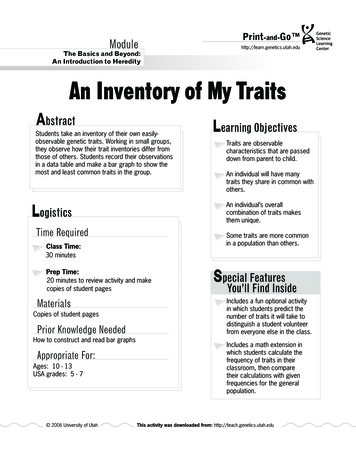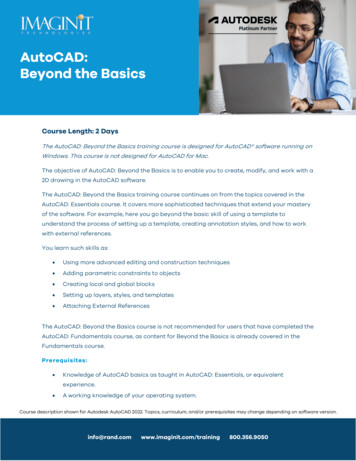
Transcription
ModuleThe Basics and Beyond:An Introduction to HeredityPrint-and-Go http://learn.genetics.utah.eduAn Inventory of My TraitsAbstractStudents take an inventory of their own easilyobservable genetic traits. Working in small groups,they observe how their trait inventories differ fromthose of others. Students record their observationsin a data table and make a bar graph to show themost and least common traits in the group.LogisticsPrep Time:20 minutes to review activity and makecopies of student pagesPrior Knowledge NeededHow to construct and read bar graphsAppropriate For:Ages: 10 - 13USA grades: 5 - 7 2006 University of UtahAn individual will have manytraits they share in common withothers.Some traits are more commonin a population than others.Class Time:30 minutesCopies of student pagesTraits are observablecharacteristics that are passeddown from parent to child.An individual’s overallcombination of traits makesthem unique.Time RequiredMaterialsLearning ObjectivesSpecial FeaturesYou’ll Find InsideIncludes a fun optional activityin which students predict thenumber of traits it will take todistinguish a student volunteerfrom everyone else in the class.Includes a math extension inwhich students calculate thefrequency of traits in theirclassroom, then comparetheir calculations with givenfrequencies for the generalpopulation.This activity was downloaded from: http://teach.genetics.utah.edu
Print-and-Go Modulehttp://learn.genetics.utah.eduThe Basics and Beyond:An Introduction to HeredityAn Inventory of My TraitsClassroom ImplementationQuantitiesActivity instructions: Begin by demonstrating one of the traits listed in An Inventory of MyTraits: Survey (page S-1). Ask students who possess this trait to stand.Point out the relative numbers of students standing and sitting for thetrait. Continue this process with 2-3 more traits.One copy of student pagesS-1 to S-3 Explain that traits are observable characteristics we inherit fromour parents. Some traits are common in a population (our class)while others are not. And, every person has a different overallcombination of traits that makes them unique. Divide students into groups of four or more. Have each student inthe group complete An Inventory of My Traits: Survey (page S-1)to determine their unique combination of the traits described. After students complete the survey, have them tally their groupinformation on the data table (page S-2) and draw a bar graph(page S-3). Optional: You may collect the traits data from the whole classby creating a large wall chart (see example on the left). Have arepresentative from each group fill in their data. Once all the datahas been collected, have the students make a bar graph from theclass data or make one large graph together.Optional activity: Ask students to predict how many traits they would haveto look at on the Survey in order to identify any givenclassmate as unique. Select a volunteer who would like to determine his or heruniqueness. Ask all students to stand. Have the volunteer call out one of their traits at a time,beginning with question 1 on the Survey and continuing insequence. For each trait, direct all students who do notshare that trait to sit down; students who share the traitremain standing. Once a student sits down, they do notget up again. 2006 University of UtahPer StudentCommon MisconceptionsStudents may think that the more common traitsare “better”, but this is not always the case.Sometimes traits simply show up more frequentlyin the human population.More advanced students may think that dominanttraits are more common than recessive traits.However, frequency has very little to do withwhether a trait is dominant or recessive. That is,a dominant trait is not necessarily more commonand a recessive trait is not necessarily rare in apopulation.This activity was downloaded from: http://teach.genetics.utah.edu1
Print-and-Go ModuleThe Basics and Beyond:An Introduction to Heredityhttp://learn.genetics.utah.eduAn Inventory of My Traits Continue in this way until the volunteer is the only one standing. Count the number of traits it took todistinguish the volunteer from everyone else in the class. Compare this number with the students’predictions. Repeat with several additional volunteers.Math extension: Have students practice converting fractions to decimals, then decimals into percentages by calculatig thefrequency of the following traits in your classroom: tongue rolling, handedness and hand clasping. Students can then compare their calculated frequencies with those for the general population (provided inthe table below).Example: # of students with the trait/# of students in the class x 100 %15 tongue rollers / 21 students in the class x 100 71%TraitTongue rollingHandednessHand claspingFrequency in General Population*Can roll tongue – 70%Cannot roll tongue – 30%Right handed – 93%Left handed – 7%Left thumb on top – 55%Right thumb on top – 44%No preference – 1%*Frequencies for traits are fromOnline Mendelian Inheritance In Man(see http://www.ncbi.nlm.nih.gov/omim/).StandardsU.S. National Science Education StandardsGrades 5-8:Content Standard C: Life Science - Reproduction and Heredity Every organism requires a set of instructions for specifying its traits. Heredity is the passage of theseinstructions from one generation to another. The characteristics of an organism can be described in terms of a combination of traits.AAAS Benchmarks for Science LiteracyGrades 3-5:The Living Environment: Heredity - Some likenesses between children and parents, such as eye color in humanbeings, or fruit or flower color in plants, are inherited. Other likenesses, such as people’s table manners orcarpentry skills, are learned. 2006 University of UtahThis activity was downloaded from: http://teach.genetics.utah.edu2
Print-and-Go ModuleThe Basics and Beyond:An Introduction to Heredityhttp://learn.genetics.utah.eduAn Inventory of My TraitsFor offspring to resemble their parents, there must be a reliable way to transfer information from onegeneration to the next.CreditsActivity created by:Molly Malone, Genetic Science Learning CenterApril Mitchell, Genetic Science Learning CenterLouisa Stark, Genetic Science Learning CenterHarmony Starr, Genetic Science Learning Center (illustrations)This activity was adapted from: “Alike But Not The Same” in Human Genetic Variation, NIH CurriculumSupplement Series (1999). Available at hschool.htm.FundingOriginal funcing:A Howard Hughes Medical Institute PrecollegeScience Education Initiative for BiomedicalResearch Institutions Award (Grant 51000125).Additional ResourcesVisit the Teach.Genetics website to get more greatresources like these!Funding for significant revisions:Grant U33MC00157 from the Health Resourcesand Services Administration, Maternal and ChildHealth Bureau, Genetic Services Branch. Partners in the Consumer Genetics Education Network (CGEN)include HRSA, March of Dimes, Dominican Women’s Development Center, Charles B. Wang Community HealthCenter, Genetic Science Learning Center at University of Utah, Utah Department of Health and the NationalHuman Genome Center at Howard University.To learn about our permissions policy, visit http://teach.genetics.utah.edu/permissions/ 2006 University of UtahThis activity was downloaded from: http://teach.genetics.utah.edu3
NamePrint-and-Go Datehttp://learn.genetics.utah.eduAdapted from “Alike But Not The Same” in Human Genetic Variation, NIH Curriculum Supplement Series 1999. http://science-education.nih.govAn Inventory of My Traits - SurveyWhat combination of these traits do you have? Complete the survey to find out.1.I have detached earlobesYesNo2.I can roll my tongueYesNo3.I have dimplesYesNo4.I am right-handedYesNo5.I have frecklesYesNo6.I have naturally curly hairYesNo7.I have a cleft chinYesNo8.I have allergiesYesNo9.I cross my left thumb over myright when I clasp my handstogetherYesNo10. I can see the colors red and green( I am not color blind)YesNo11. The hairline on my forehead isstraight.YesNo12. I am a:MaleFemale 2006 University of UtahThis activity was downloaded from: http://teach.genetics.utah.eduS-1
NamePrint-and-Go Datehttp://learn.genetics.utah.eduAdapted from “Alike But Not The Same” in Human Genetic Variation, NIH Curriculum Supplement Series 1999. http://science-education.nih.govAn Inventory of My Traits - Data TableHow many people in your group have each trait?Fill in the data table below by counting the number of people who marked “yes” andthe number of people who marked “no” for each trait.TRAITYESNODetached earlobesTongue rollingDimplesRight-handedFrecklesNaturally curly hairCleft chinAllergiesCross left thumb over rightSee the colors red and greenHave a straight hairline 2006 University of UtahThis activity was downloaded from: http://teach.genetics.utah.eduS-2
NameDate543210An Inventory of My Traits - GraphThis activity was downloaded from: http://teach.genetics.utah.eduTraitsMake a bar graph showing how many people in your group answered “yes” for each trait.Be sure to label each trait under the bar you draw for it. 2006 University of Utah# of studentsPrint-and-Go http://learn.genetics.utah.eduS-3
NamePrint-and-Go Datehttp://learn.genetics.utah.eduAdapted from “Alike But Not The Same” in Human Genetic Variation, NIH Curriculum Supplement Series 1999. http://science-education.nih.govUn Inventario de mis Rasgos - Encuesta¿Quales son los rasgos que tú tienes que se le hacen singular?Para averigüar, completa la encuesta que sigue abajo.1.Tengo los lóbulos de las orejas separadosSiNo2.Puedo hacer rollito mi lenguaSiNo3.Tengo hoyuelosSiNo4.Escribo con la mano derechaSiNo5.Tengo pecasSiNo6.Mi cabello es rizado por naturalezaSiNo7.Tengo la barbilla partidaSiNo8.Tengo alergiasSiNo9.Cuando entrelazo mis dedos pongo mi pulgarizquierdo sobre mi pulgar derechoSiNo10.Puedo ver los colores rojo y verde(No soy daltónico)SiNo11.La rayita en mi frente es rectaSiNo12.Yo soy:HombreMujer 2006 University of UtahThis activity was downloaded from: http://teach.genetics.utah.eduS-1
NamePrint-and-Go Datehttp://learn.genetics.utah.eduAdapted from “Alike But Not The Same” in Human Genetic Variation, NIH Curriculum Supplement Series 1999. http://science-education.nih.govUn Inventario de mis Rasgos - Tabla de Datos¿Cuantas personas de tú grupo tienen cada rasgo?Completa la tabla de datos que aparece a continuación contando el número de personasque marcaron “Si” y el número de personas que marcaron “No” en cada rasgo.RASGOSINOLóbulos de las orejas unidosPuede hacer rollito la lenguaHoyuelosEscribe con la mano derechaPecasCabello rizado naturalBarba partidaAlergiaCruza el pulgar izquierdo sobre elderechoPuede ver los colores rojo y verdeTenga una rayita recta 2006 University of UtahThis activity was downloaded from: http://teach.genetics.utah.eduS-2
NameDate543210 2006 University of Utah# de estudiantesPrint-and-Go S-3http://learn.genetics.utah.eduUn Inventario de mis Rasgos - GráficaHaz una gráfica de líneas mostrando cuántas personas en tu grupo contestaron “Si” encada rasgo. Asegúrate de marcar cada barra con el nombre del rasgo que estás dibujando.RasgosThis activity was downloaded from: http://teach.genetics.utah.edu
Molly Malone, Genetic Science Learning Center April Mitchell, Genetic Science Learning Center Louisa Stark, Genetic Science Learning Center Harmony Starr, Genetic Science Learning Center (illustrations) This activity was adapted from: "Alike But Not The Same" in Human Genetic Variation, NIH Curriculum Supplement Series (1999).











